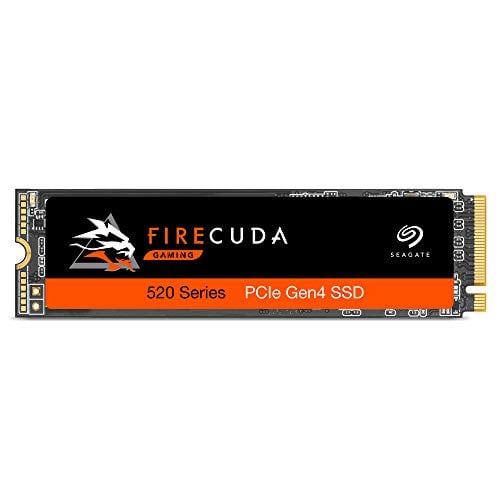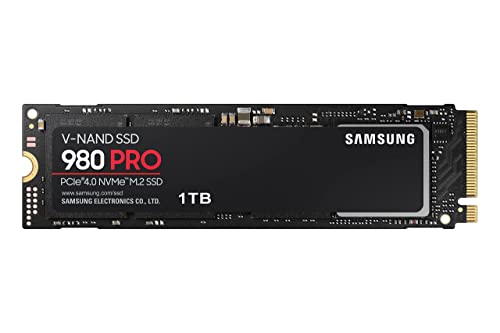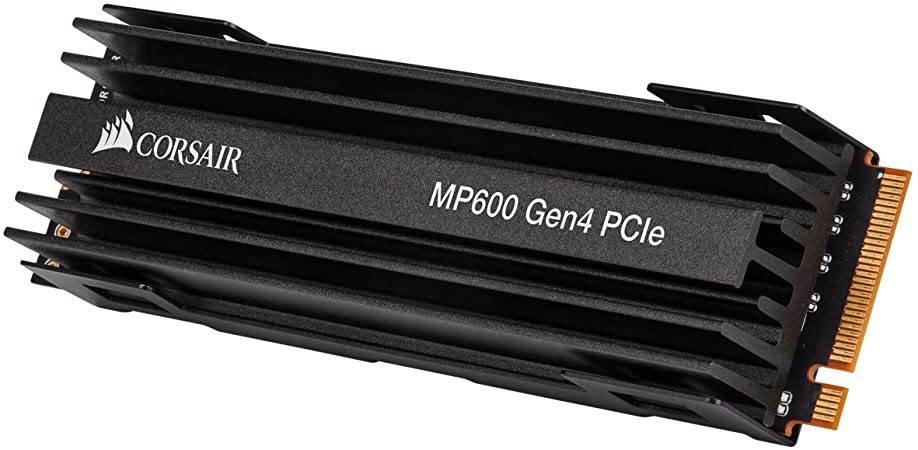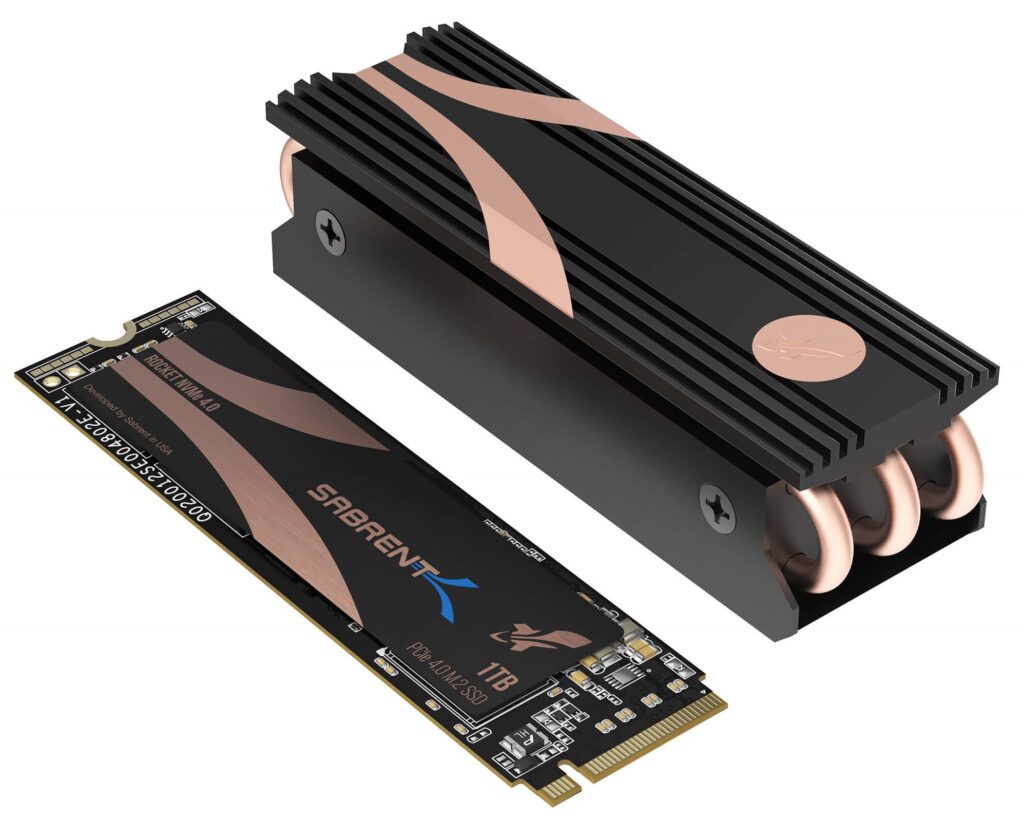The 5 Best PCIe Gen 4 SSDs – Best Performing M.2 Options
Choosing the best PCIe 4.0 SSD for your brand new Gen 4 rig is not as straightforward as you might think. The fourth generation of PCI Express standard was introduced in the desktop market with the introduction of AMD’s X570 chipset, and later AMD’s mid-range B550 chipset also got support for the PCIe Gen 4 interface. Basically, PCIe Gen 4 doubles the bandwidth of the interface when compared to PCIe Gen 3, and that can have a big impact on the theoretical speeds of the devices that use the PCIe interface. While graphics cards have still not saturated the older PCIe Gen 3 link to the fullest, there is an application of PCIe Gen 4 that is useful today. Indeed that is the PCIe Gen 4 SSDs that use the new PCIe Gen 4 link to break the limits of what was possible in terms of speed with the older link.
While PCIe Gen 3 NVMe drives were in no way slow, the technology always finds a way to improve itself even if the need is not felt at the moment. PCIe Gen 3 SSDs tend to cap out at around 3500 MB/s sequential read speeds, while the PCIe 4.0 SSD options can deliver sequential read speeds of up to an eye-searing 5000 MB/s with write speeds not far off either. These drives do require active cooling in most scenarios, and many of them ship with included heatsinks as well. You will also need a PCIe Gen 4 M.2 slot in either a B550 or an X570 motherboard from AMD as of the time of writing.
The 5 Best PCIe 4.0 SSD – Our Recommendations
| # | Preview | Product Name | Award | Details |
|---|---|---|---|---|
| 1 |  | Corsair Force MP600 | Best Overall PCIe 4.0 SSD | Check Price |
| 2 |  | Sabrent Rocket NVMe 4.0 | Best Value PCIe 4.0 SSD | Check Price |
| 3 |  | Gigabyte AORUS NVMe Gen4 | Best All-Rounder PCIe 4.0 SSD | Check Price |
| 4 |  | Seagate FireCuda 520 | Best Seagate PCIe 4.0 SSD | Check Price |
| 5 |  | Samsung 980 PRO | Best Premium PCIe 4.0 SSD | Check Price |
| # | 1 |
| Preview |  |
| Product Name | Corsair Force MP600 |
| Award | Best Overall PCIe 4.0 SSD |
| Details | Check Price |
| # | 2 |
| Preview |  |
| Product Name | Sabrent Rocket NVMe 4.0 |
| Award | Best Value PCIe 4.0 SSD |
| Details | Check Price |
| # | 3 |
| Preview |  |
| Product Name | Gigabyte AORUS NVMe Gen4 |
| Award | Best All-Rounder PCIe 4.0 SSD |
| Details | Check Price |
| # | 4 |
| Preview |  |
| Product Name | Seagate FireCuda 520 |
| Award | Best Seagate PCIe 4.0 SSD |
| Details | Check Price |
| # | 5 |
| Preview |  |
| Product Name | Samsung 980 PRO |
| Award | Best Premium PCIe 4.0 SSD |
| Details | Check Price |
Last Update on 2024-07-26 at 15:25 / Affiliate links / Images from Amazon Product Advertising API
They say you can’t buy time with money. Well in regards to SSD especially PCIe Gen 4.0 SSDs this is somewhat false. Getting a faster SSD will completely change your computing experience. In modern gaming, you can absolutely feel the differences between HDD and SSD. If you are performing time-sensitive productivity tasks such as video editing or just want faster loading times as a gamer without properly reading the loading screen tips, you might just want to splurge the cash on a PCIe Gen 4 SSD. Without any further ado, let’s dig into our tier list for the best 2022 PCIe 4.0 SSD options on the market.
1. Corsair Force MP600
Best Overall PCIe 4.0 SSD
Pros
- Extremely High Speeds
- Solid IOPS Performance
- Cheaper Than Many Other Options
- Included Hefty Heatsink
- NAND Layering
Cons
- Write Speed Marginally Lower Than Others
- Still Not Objectively Cheap
Capacity: 500GB, 1TB, 2TB | NAND Flash Type: 3D TLC NAND | Read Speeds: 4950 MB/s | Write Speeds: 4250 MB/s | Endurance Rating: 1800 TBW (for 1TB) | Warranty: 5 years
One of the most popular PCIe Gen 4 NVMe SSDs on the market, the Corsair Force MP600 takes the top spot in our roundup due to its incredible performance, reliability, overall feature set, and trust of Corsair. The SSD comes in capacities of 500GB, 1TB, and 2TB which is a nice diverse range of options for various users with different needs. Corsair has made this SSD in the standard M.2 2280 form factor which is supported on most motherboards so there is nothing to worry about there as well.
As far as the internals of the drive go, Corsair has opted for 3D TLC NAND which strikes a perfect balance between speed and capacity of the NAND cells themselves. The controller used in the MP600 is the Phison PS5016-E16, which is the first PCIe 4.0 compliant SSD controller, and it is manufactured on the 28nm process. The overall component choice allows the MP600 1TB and 2TB variants to reach sequential read and write speeds of up to 4950 MB/s and 4250 MB/s respectively. Speeds like this were unheard of with PCIe Gen 3 drives just a generation ago. Even the best of the best, the Samsung 970 EVO Plus, capped out at around 3500 MB/s sequential reads.

Corsair has also included a nice finned aluminum heatsink with the Force MP600 which allows the drive to maintain a stable operating temperature between 0C and 70C, although you can use the motherboard’s built-in heat spreaders as well. Corsair’s heatsink is a bit bulky and the user might run into some clearance issues on certain motherboards.
The MP600 is backward compatible as well with the PCIe 3.0 x4 interface which is to be expected of most of these Gen 4 drives as well. The MP600 also supports AES 256-bit encryption for security, and is shock resistant with a rating of 1500 G. The SSD is rated for 1800 TBW in terms of Endurance and Corsair has provided a 5-year warranty with the Force MP600 for your ease of mind.
Really, the MP600 does not carry any significant drawback. It is a fantastic, blazing fast, highly reliable drive from a trustworthy manufacturer and it has our recommendation provided you can afford it. This makes it the best PCIe 4.0 SSD overall.
2. Sabrent Rocket NVMe 4.0
Best Value PCIe 4.0 SSD
Pros
- Read Speed Up To 5GB/s
- Cheaper Than Many Other Options
- Great IOPS Performance
- Included Heatsink With Heatpipes
- Value For Money
Cons
- Brand Loyalists Might Not Trust Sabrent
- Heatsink Sold Separately
Capacity: 500GB, 1TB, 2TB | NAND Flash Type: TLC NAND | Read Speeds: 5000 MB/s | Write Speeds: 4400 MB/s | Endurance Rating: 1800 TBW (for 1TB) | Warranty: 5 years
Sabrent might be a lesser-known SSD manufacturer among heavy-hitters like Corsair, Seagate, and Samsung but there is no doubting the quality of their drives. They delivered some excellent PCIe Gen 3 NVMe drives, and their Sabrent Rocket 4.0 PCIe Gen 4 SSD is one of our favorite drives of its class. Not only does the drive feature top-of-the-line components but it also delivers some of the most amazing numbers in terms of performance we have seen from a Gen 4 drive.
Related Read: Best NVMe PCIe Add-in Cards
The drive is available in 500 GB, 1TB, and 2TB capacities which cover most of the common size demands in the market today. Sabrent has also made the Rocket 4.0 in the 2280 form factor which is the industry standard at this point. The drive uses the same Phison PS5016-E16 controller as the Corsair MP600, but the NAND Flash has been changed to TLC NAND by Toshiba (BiCS4 96L TLC NAND to be precise). This allows the Rocket to deliver read speeds of up to 5000 MB/s for all of its variants. The write speeds come in at a blazing 4400 MB/s for the 1TB and 2TB variants while it is a bit slower for the 500GB variant.

Sabrent has included one of the most impressive SSD heatsinks we have ever seen on an SSD, however, Sabrent includes the option to omit the purchase of the heatsink should the user see fit. This can be a useful option for those users whose motherboards feature a built-in SSD heatsink. The Sabrent heatsink not only features a finned aluminum block, but it also has 3 copper heat pipes running through it which is a very interesting and unique design for an SSD heatsink. We also ranked this heatsink as the best NVMe SSD heatsink in our roundup.
The SSD has an operating temperature range of 0C to 70C just like the MP600, while the endurance rating of the 1TB version of the Rocket 4.0 is 1800 TBW. Sabrent has also rated the drive as 1500G shock-resistant, and it is also backwards compatible with PCIe Gen 3 x4 slots. Backed by a 5-year warranty from Sabrent, the Rocket 4.0 makes an extremely compelling offering especially due to its attractive price.
Overall, the Sabrent Rocket 4.0 is one of the most impressive budget PCIe Gen 4 SSDs we have seen so far. With its sky-high performance numbers, its impressive heatsink and build quality, to its attractive price, the Rocket 4.0 makes an attractive option for anyone looking for a Gen 4 SSD, and willing to give Sabrent a chance.
3. Gigabyte AORUS NVMe Gen4
Best All-Rounder PCIe 4.0 SSD
Pros
- Extremely High Speeds
- Included Copper Heatspreader
- Supports NAND Layering
- Good Performance In Terms Of IOPS
Cons
- A Bit Pricey
- Aesthetically Not Neutral
- Quick Thick With The Heatsink On
Capacity: 500GB, 1TB, 2TB | NAND Flash Type: 3D TLC NAND | Read Speeds: 5000 MB/s | Write Speeds: 4400 MB/s | Endurance Rating: 1800 TBW (for 1TB) | Warranty: 5 years
Gigabyte has entered the PCIe Gen 4 SSD market with their AORUS NVMe Gen4 SSD which is a premium alternative to the ones already mentioned in our roundup. One of the most striking features of the AORUS Gen4 SSD is that it features a full copper heatsink that works amazingly well due to the high thermal conductivity of copper as compared to aluminum. In fact, potential buyers might want to remove their motherboard’s built-in heatspreader altogether and use this drive with the included copper heat spreader for improved thermals. This is a nice step from Gigabyte.
The drive also comes in the 500GB, 1TB, and 2TB standard capacities, and is made in the 2280 M.2 form factor. The drive uses the same Phison PS5016-E16 PCIe Gen 4 controller that was found on the other drives, an external DRAM cache, and Toshiba BiCS4 TLC NAND Flash memory. This allows the AORUS Gen4 SSD to reach blistering-fast speeds of 5000 MB/s sequential reads and 4400 MB/s sequential writes. The 500GB variant has somewhat slower write speeds though.

The copper heatsink does a great job of keeping the drive between its recommended operating temperatures of 0C and 70C, and while that is great news, the heatsink does take points away from the overall look and aesthetics of the drive. While the heatsink performs admirably, the gold/copper color of the heatsink sticks out like a sore thumb when installed in a motherboard and has the potential to clash with the color scheme of the build. Users might want to remove the heatsink and install it under a motherboard heat spreader if that is the case.
Providing an endurance rating of 1800TBW for the 1TB version and 3600TB for the 2TB variant, as well as a 5-year warranty, Gigabyte is taking the right steps in making the AORUS Gen4 drive a viable alternative to the drives mentioned above. The high price of the Gigabyte, however, might push potential buyers towards either the Sabrent or the Corsair with little to lose in the process. Nonetheless, this SSD is also a contender for the title of the best PCIe 4.0 SSD.
4. Seagate FireCuda 520
Best Seagate PCIe 4.0 SSD
Pros
- Neck-and-Neck With Other Drives In Performance
- Good Endurance
- Up To 5 GB/s Sequential Read Speeds
- Supports NAND Layering
Cons
- More Expensive Than Other Options
- No Included Heatsink
- Seagate's Reputation in Storage Is Not The Best
Capacity: 500GB, 1TB, 2TB | NAND Flash Type: 3D TLC NAND | Read Speeds: 5000 MB/s | Write Speeds: 4400 MB/s | Endurance Rating: 1800 TBW (for 1TB) | Warranty: 5 years Limited
Another almost identical offering on paper comes from the renowned hard drive manufacturer, Seagate, who has entered the PCIe Gen4 market with their FireCuda 520. While Seagate might not have the most stellar reputation in the storage world in terms of reliability, the FireCuda 520 does seem like a really good drive when you look at the overall specs. It is offered in 500GB, 1TB, and 2TB variants, and is utilizing the M.2 2280 standard form factor as well.
The FireCuda 520 uses a Phison E16 Controller and uses a 96-layer TLC NAND memory from Toshiba. This allows the FireCuda to reach its advertised sequential read and write speeds of 5000 MB/s and 4400 MB/s respectively. It should be noted again that the write speeds of the 500GB variant are limited to 2500 MB/s, which is still pretty fast if you think about it. Unfortunately, Seagate has opted not to include any heatsink with the FireCuda 520 and that seems to be a negative point that most of the other SSDs have managed to avoid easily.

The lack of heatsink might not have been that big of a deal if the SSD was cheaper than its alternatives in the market. That could’ve been chalked off as a cost-saving measure, but the FireCuda is in fact more expensive than all of the SSDs mentioned in the article up to this point. This is a serious point of concern for Seagate since the FireCuda 520 does not offer anything that the other drives do not offer in this department already.
Moreover, Seagate has had reliability issues with their hard drives and their reputation is not the best in the storage space. Seagate has pioneered the rise of Solid State Hard Drives, but their reliability is still a question mark among enthusiasts. Although Seagate has provided an 1800 TBW endurance rating and a 5-year warranty with the FireCuda, that still does not make it any better in terms of numbers than the Sabrent, Corsair, or AORUS options. Shame, since the drive performs really well.
5. Samsung 980 PRO
Best Premium PCIe 4.0 SSD
Pros
- Fastest Speeds In The Industry
- Special MLC NAND
- Samsung's Reliability
Cons
- No 2TB Option
- No Included Heatsink
- Low Endurance Rating
- Extremely Expensive
Capacity: 250GB, 500GB, 1TB | NAND Flash Type: Samsung V-NAND 3bit MLC | Read Speeds: 6900 MB/s | Write Speeds: 5000 MB/s | Endurance Rating: 300 TBW (for 500GB) | Warranty: 5 years Limited
Our last pick of the roundup is a drive we expected to find at the top of this list. The Samsung 980 PRO is an incredibly fast drive that delivers record-breaking numbers in terms of speed in the entire PC industry. However, it has too many glaring flaws that make it a hard recommendation for most users.
The Samsung 980 PRO is a really fast drive, let’s get that out of the way. While other PCIe Gen 4 drives cap out at 5000 MB/s reads and 4400 MB/s reads, the 980 PRO can deliver read and write speeds of up to an eye-watering 7000 MB/s and 5000 MB/s respectively for the 1TB version. These kinds of speeds are still unheard of in the consumer PC space and are only possible with this one drive out of hundreds of drives in the market. Samsung has achieved these speeds thanks to the Samsung Elpis Controller and V-NAND 3-bit MLC memory chip. Fast sequential speeds, however, only make up one part of the picture.

That is where the positives end for the 980 PRO. Samsung has not included any heatsink with the 980 PRO and has instead used nickel coating to manage the controller’s heat level. The 980 PRO also uses the heat spreader label to deliver effective thermal control of the NAND chip, which can deliver acceptable results. The missing heatsink might not be as big of a problem though, as the missing 2TB capacity. Samsung only offers the 980 PRO in 250GB, 500GB, and 1TB capacities, which is not the kind of market that you’d expect Samsung to target. Nobody should be buying a really expensive 980 PRO in a 250GB size. Moreover, professionals in need of the extra storage and the high speeds are left without a 2TB option which is a really weird decision from Samsung. In addition to that, Samsung is only providing an endurance rating of 300TBW for the 500GB model which is quite a bit lower than other drives in this category.
Adding insult to injury is the price of the 980 PRO. With the 1TB version coming in at a whopping $229 at the time of writing, the Samsung 980 PRO is at least $30-50 more expensive than the other options in this roundup, and it makes it difficult for us to recommend this bleeding-edge blazing fast SSD over the more reasonable offerings mentioned above. This might not be the best PCIe 4.0 SSD if you plan to maximize the value for money.
Factors To Consider While Buying
NVME SSDs started to become more mainstream to consumers after 2015. With the ever-increasing demand for faster and faster SSDs, every year or so we see many manufacturers come up with SSD’s which are faster, store more data, and have all the bells and whistles. Today we are talking about PCIe Gen 4.0 SSD which was recently implemented in around early 2020 thanks to its inclusion in B550 and X570 motherboards. The PCIe Gen 4.0 is capable of pushing data at rates of 16 GT/s, a large improvement from PCI Gen 3.0 with 8 GT/s. Despite using the same technology, not every SSD on the market is different. Factors such as speeds, NAND flash, DRAM cache, IOPS (Input-output per second), Endurance ratings (TBW) also need to be regarded when purchasing the PCIe 4.0 SSD for your rig.
DRAM Cache
Yes, you read that correctly an SSD needs its own primary storage to store data. This part contains the addresses for every bit of data stored on the NAND flash which otherwise would take your computer longer to fetch from the SSD. Many SSD’s keep moving data from time to time to prevent premature lifespan degradation known as wear leveling. SSD RAM keeps a mapping of data locations such that your PC will take a shorter time to fetch data for the best efficiency. Cache in DRAM on the other hand is its capacity to store that data that will be required by the SSD to perform data transfers. Terms such as SLC, MLC, and TLC, etc. These are NAND flash technologies crucial for speed and data storage efficiency. While Single or Multiple Layer Cells store fewer data and are slower, Triple Layer Cells fall short in lifespan.
Endurance Ratings (TBW)
The endurance of an SSD is measured in Terabytes written or TBW. This should give you a general idea of how long an SSD lasts before its expiration. Although an SSD in general, lasts longer than an HDD, in frequent high load scenarios such as video content creation or any other task that requires a serious amount of data handling can lead to premature lifespan degradation. TBW of a typical SSD ranges from 60 to 150 terabytes per second. For a high-end user who does lots of writes each day, these endurance ratings are super crucial to understand so that one doesn’t end up with a broken drive the next day he wakes up from his usual routine. It’s great to know TBW ratings so after a period of use, you should change or backup your drive to avoid any final day hassle.
While these are some of the more common factors to consider while buying an SSD, there are still numerous others that can’t be mentioned here.
PCIe 4.0 SSD FAQs
Yes, they absolutely are! They can reach double transfer rates compared to their PCIe Gen 3 predecessors. This is great for read-and-write intensive tasks such as transferring files, loading games, and video editing. They can offer a huge benefit in terms of transfer speeds for professionals who have to move large files frequently on the same drive.
PC’s Gen 4 uses an M.2 interface and will work with any such slots. While yes, you can use a PCIe Gen 4 drive on a Gen 3 motherboard’s M.2 slot, it will be limited to Gen 3 speeds due to the inherent limitations of the platform and the bandwidth cap of PCIe Gen 3. Make sure that your motherboard support Gen 4.0 PCIe or plan to upgrade to one when shopping for these specific SSDs.
NVMe stands for Non-volatile Memory Express. While they are not the same, they work together in a sort of way. NVMe is just a protocol for storage used by many high-speed PCIe SSDs. NVMe is often used to refer to PCIe Gen 3 SSDs while the Gen 4 SSDs are referred to by using the PCIe Gen 4 name. This differentiation is not accurate since both of them are NVMe drives on a basic level.
The PCIe Gen 4.0 is capable of having read speeds up to 61% faster than previous Gen 3.0s. Meanwhile, the write speeds are 41% faster on average compared to the last generation. This means that PCIe Gen 4 SSDs can reach sequential read speeds of up to 7000 MB/s, which is a figure that is completely out of this world when compared to normal SSD speeds.
 Check Price
Check Price


